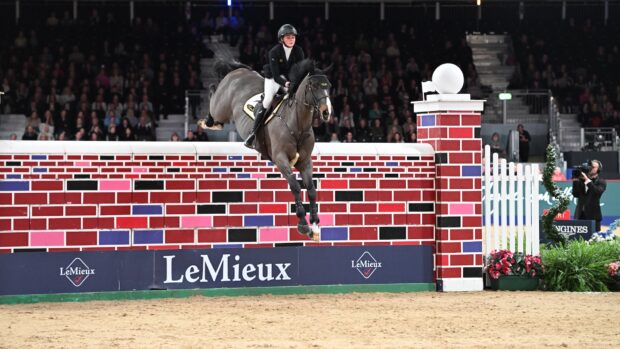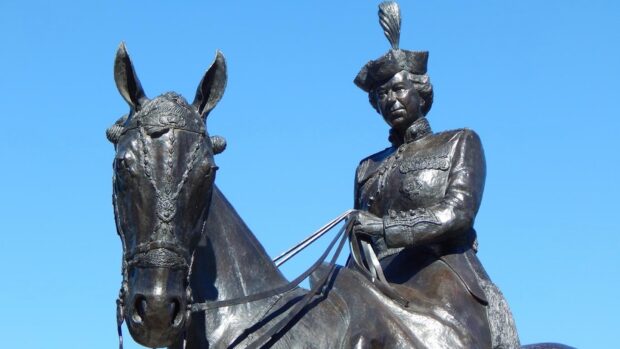Horses and hounds go together – or do they? The BHS reports there have been 706 dog attacks on horses in the past two years, although it is believed the figures could be much higher as many incidents go unreported. These are not rare occurrences, which means all riders need to know what to do if they find themselves dealing with a situation involving out-of-control dogs around horses.
Sophie Rubie was hacking out in Bramshill Forest, Hants, when a large, muscular dog on a choke-chain pulled away from his handler and began jumping up at her mare, barking and snarling.
“My horse was amazing at trying to protect herself and me, she kept spinning round to face the dog, and striking out with her forelegs,” says Sophie. “I was screaming at the owner, but they couldn’t get their dog back. After what seemed like an age but was probably a few minutes, I managed to gallop away down a long sandy track, and the dog gave up chasing. I’m not sure if I did the right thing, but at least we got away unscathed.”
Many riders aren’t so lucky. In the past two years, the BHS reported three horse fatalities due to dog attacks, with 75 horses and 102 humans injured. Many dog attacks do not involve the dog actually biting the horse. Injuries are often caused by the dog chasing the horse, the rider falling off and injuring themselves, or the horse suffering or causing damage while running loose and panicking.
The Dangerous Dogs Act 1991 makes it a criminal offence to allow a dog to be dangerously out of control, whether on private land or in a public place. This means that the owner should be able to control the dog instantly and recall it, whatever the circumstances. However, just because it is illegal does not mean it never happens, so you need to be prepared.
Dog trainer and behaviourist Helen Masters, who is also a rider, says that most dogs “quickly back off once they have appreciated the sheer size of the horse”.
“However, dogs are by nature predatory, and some are extremely prone to chasing and herding,” she explains. “To these dogs, and those who may not be well trained and have no impulse control, any thing that is going quickly is game on! I would say from experience 90% of incidents happen when a horse is trotting, cantering or galloping. To a pet dog this is a game of tag.”
Out-of-control dogs around horses: what to do
If you spot a dog on its own, without a handler nearby, it may leave your horse well alone. However, even friendly dogs can get excitable, cause your horse to spook, or chase them for fun. Make this less of a likelihood by slowing to a walk, and giving the dog a wide berth so that they do not feel threatened or provoked. Call out that you are passing, in case the owner is near enough to control their dog and simply wasn’t aware of your presence. They are more likely to spot you if you’re wearing one of the best high-vis options for horse riders.
Helen says there are ways that you can prevent what a dog may see as a fun game of chase from escalating.
“Stop, as quickly as possible,” she says. “The horse may not want to stop due to being chased and is going flat-out to get away. In this instance you can either hope that the dog gets worn out, gets too close to a hoof and backs off altogether, or sadly if you have a crop you may need to use it for the safety of all involved. If you can circle there is more chance of being able to slow things down and stop your horse. Either way, it makes for an unpleasant experience.
“If you can stop then just stand still and hope the owner is not too far behind. If the dog continues to be a nuisance, then I would dismount, and the dog would meet me and be backed off my horse by a very assertive forward movement and a back-off command. I would continue to do this until such time as the owner appeared or the dog retreated.
“Should there be no sign of an owner, again dismount, get a hold of the dog (pray it has a collar on) and walk with it back to your lorry or yard. Or if the dog and the horse can stay still, try calling the number on the dog’s collar, which by law all dogs should have on in a public place. Lastly, if no collar, improvise with a stirrup leather as a make-do lead until you can get help or your horse safely back home or to the lorry.”
If the dog shows signs that it may attack – such as barking, growling and jumping up – try to stay calm. The BHS advises:
- Distance yourself from the dog by riding away
- Protect young or vulnerable riders if possible and safe to do so
- Keep the horse’s head away from the dog
- Allow your horse to defend itself
- Make a note of any identifying details of either the dog or their owner
Helen always wears a riding hat camera on her helmet in case of situations like these.
“If you are thrown, your horse gets bitten or injured as a result, or the dog does, then hopefully you have video evidence of the incident at hand,” she says. “Try as hard as you can to stay calm and rational, and in doing so the likelihood of you all coming out of the situation unscathed is very much higher.”
If your horse has suffered any injury, call the vet immediately. You may need to summon an emergency vet to the incident itself if you cannot safely walk the horse home, for instance if there is severe bleeding, lameness or shock. Even if the injury looks superficial, a dog’s saliva is full of bacteria which may cause infection.
Once the situation has been diffused, and assuming you and your horse are safe, try to get the owner’s contact details in case the incident needs following up. Report any incident to the Police and ask them to refer it to the Dog Legislation Officer – an expert in canine matters – which every police force is recommended to have. You should also report the incident to the BHS, whether or not you are a member, as your information can be used to improve equine safety.
Are you a rider? Here’s how to behave around dogs
“Riders must be equally respectful to dogs and their owners alike,” says Helen. “Ninety-nine percent of the time, owners put their dogs back on a lead and stand still while you pass. You should always thank them for their consideration. Furthermore, if you were foolish enough to trot or canter past at a rate of knots, not only is this extremely rude but outright stupid as you are asking to be chased. There may be times that you do not see a dog initially, but the second you do, slow down, stop and apologise.”
Helen also recommends desensitising your horse to dogs if you can.
“Walk out with a well-trained dog and its handler. Having the dog run alongside while you trot will help your horse get used to dogs,” she says.
Are you a dog walker? Here’s how to behave around horses
Dogs should always be kept on a lead or within sight of their walker, with reliable confidence that the dog can be recalled instantly.
Familiarise your dog to horses in a controlled situation so that you can train them not to react, but to stay calm if they meet horses while out on a walk. Teach your dog to sit and stay, quietly, while the horse passes.
“I would walk the dog on its lead alongside a horse that is being ridden,” says Helen. “Go near fields where horses graze and walk them around outside. If the dog gets excitable and shows interest, correct them and ask them to leave it and redirect. Riding schools may let you bring your dog on site and watch, on a lead, at a distance to help teach your dog manners.”
According to the Dangerous Dogs Act 1991, if your dog is deemed dangerously out of control, the consequences are severe. The dog may be destroyed, you may be banned from keeping dogs and even be sentenced to two years’ imprisonment. At the lesser end of the scale is a potential £5,000 fine, an order to muzzle your dog and keep him on a lead in public.
You may also enjoy reading…

Best dog training leads to teach your pup obedience, heel work and recall

Reliable recall: the best whistles to train your dog

How to master recall

Be seen with these hi viz jackets and rider accessories

Double the fun: how to run with your dog

Dazzle drivers with the best hi vis dog coats for winter walks

Subscribe to Horse & Hound magazine today – and enjoy unlimited website access all year round
Horse & Hound magazine, out every Thursday, is packed with all the latest news and reports, as well as interviews, specials, nostalgia, vet and training advice. Find how you can enjoy the magazine delivered to your door every week, plus options to upgrade your subscription to access our online service that brings you breaking news and reports as well as other benefits.




